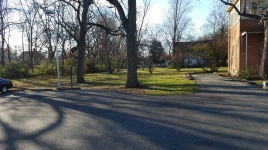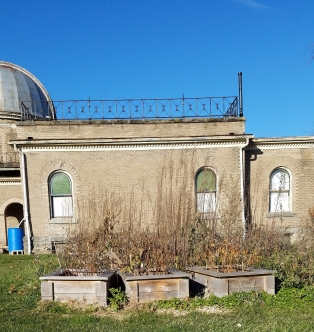Establishing Bee Hives on Ohio Wesleyan University’s Campus
Summary:
The goal of my project was to establish permanent bee hives somewhere on the campus of Ohio Wesleyan University. These hives would be used for educational purposes for the Ohio Wesleyan community; including OWU courses and individual student projects. We also hope that the construction of these hives will also help raise awareness about bees and help to make students realize the important role they play. In order to accomplish our goal, we established a new club at Ohio Wesleyan, the beekeeping club. OWU student, Peyton Hardesty, whom I have been in contact with over the course of this project, heads this club. Beekeeping club has been approved by the student government and has already held a few meetings, official elections will be held in the spring.
Why Bees?
Bees are important to human life, providing us with products like honey and wax. However, Bees are most notably a vital organism to our planet and its health. Bees play a critical role in pollination and are directly responsible for 20% of all plant pollination worldwide. This amount is nearly double compared to any other pollinating species. This goes to show how critical bees really are, especially in industries like agriculture, which is vital to the economy of the United States and much of the world. Bees produce nearly twenty billion dollars of crops yearly in the United States alone, pollinating over four hundred different types of agricultural plants. This is why many states, including Ohio, have recognized the importance of bees and have established laws in attempts to protect them. Bees pollinate many fruits and vegetables that are key to the Ohio economy, including but not limited to apples, melons, cucumbers, pumpkins, sunflowers, and canola. In 1904, the state of Ohio passes House Bill 28 and has been involved with and monitoring beekeeping in the state ever since. The Ohio Apiary Program conducts county and state wide inspections in attempts to keep a healthy Ohio bee population. In 2015, 4,838 beekeepers registered in accordance with Ohio Revised Code section 909.02 that represents 6,571 apiaries, and an estimated 36,235 colonies.
The bee population has been decreasing dramatically for some time now. Many scientists claim that the bees are dying at an alarming rate and if this continues bees could be gone forever. For 2015-2016 the overall colony loss rate was forty four percent, this rate is much higher then the acceptable loss rate of seventeen. This should be very alarming to humans, since bees are so crucial to our world for the reasons listed above. Bees are declining for a number of reasons. Mites are the number one cause for the death of bee colonies but loss of habitat, pesticides, herbicides, and insecticides are all major factors as well. With bees being so vital to our world and with their struggling population I hope that establishing beehives around campus will be a relatively easy way for us at OWU to do our part and help the cause
Methods and Results:
The establishment of bee hives on campus has been attempted previously, however the attempt deemed unsuccessful. I began my project by researching this previous attempt and trying to understand why it failed. What I found was that Meg Deeter, a recent OWU grad, had written a small grant to establish two hives behind Sanborn Hall at the Monet Gardens in 2016. Meg worked alongside the head apiarist at Stratford Ecological Center, who is the current mentor of OWU bee keeping club president Peyton Hardesty, to establish these hives. Unfortunately both hives over-wintered very poorly and consequently failed. After examining the reasons for the collapse of the hives it was determined that the chosen location was far too shady, there was a large infestation of hive beetle, and it was suspected that Buildings and Grounds fertilizes in these locations, but no one knows for certain. However, the bee keeping club and the university feel they have learned a lot from this past failure and are very optimistic about the future of bees at OWU.
My next step was to join the newly established beekeeping club and presenting my project idea, in hopes to cooperate with them to achieve the goal of bee hives on campus. Since joining, I have attended the meetings, helped to figure out the logistics of the hives, spread awareness around campus, recruited new members, and created a website for the use of the club. (https://sites.google.com/owu.edu/beeowu/bee-club-owu)
The club has been working hard since its creation, and along with collaboration from nearby Stratford Ecological Center, plan to establish permanent bee hives on campus in the spring of 2018. I was tasked with the job of scouting multiple locations, noting the positives and negatives of each site. This information was then used to select the location that the hive will be placed, which is currently proposed to be at the Monet gardens.
Unfortunately it was not possible to install the hives during this semester because it would be hard on the bees to be established before winter. Stratford has agreed to donate to the beekeeping club and the university a hive (possibly two) and the bees themselves. This was a pleasant surprise and reduced the work required for my project. I was originally planning to take on the task of determining what materials would be necessary to establish the hives, determine the amount of money that would be needed, and then applying for a grant to purchase these materials. However due to the generosity of Stratford, none of this was required. Stratford and the beekeeping club made the decision that the implementation of a top bar hive would be the most logical choice. A top bar hive (picture below) was chosen because they are relatively easy to use and are great for educational purposes, making it easier to observe the bees. The club feels that having permanent bee hives on campus will be a great opportunity for OWU students to be exposed to these amazing creatures and to help educate them on the important role that bees play within our world.

Future Plans:
As stated above we plan on being able to install the hives during the spring semester of 2018. I hope to continue to work with Peyton, the beekeeping club, and Stratford to see this project through. The area that we have selected for the bee hives will need to be prepped for the arrival of the bees and the bees will need to be taken care of. I would not be opposed to helping with any hive maintenance or doing things such as helping to harvest the honey. I also hope that after the installation of the hives the OWU community is using them. I, along with the beekeeping club, will hopefully encourage students and professors to utilize these resources for their projects or their classes.
Recommendations:
I would recommend that Ohio Wesleyan and the beekeeping club continue and build the relationship that has been established with the Stratford Ecological Center. They have been very generous in helping OWU with this project and have experience dealing with bees and are willing to help us along the way. I think it would also be useful to educate buildings and grounds about where the hives will be located and the kind of conditions that will be required to keep the bees healthy and avoid a colony failure like last time. It may also be a good idea to create some signage to post around the area, warning people that bee hives are present and what shouldn’t be done in this area (ex. Spraying fertilizer). Finally, I think it is necessary to inform the Ohio Wesleyan community as to what has been done so far and what our future plans are. We could do this by putting the bee website link somewhere on the OWU page, making posters/fliers, and posting in the OWU daily/The Transcript. I think this would help to raise awareness about the project and hopefully get more people interested in bees and on board with what is going on.
Contacts:
Dr. Krygier- jbkrygier@owu.edu
Peyton Hardesty- prhardes@owu.edu
Stratford Ecological Center- info@stratfordecologicalcenter.org
Appendix:
Project Presentation Link:
https://docs.google.com/presentation/d/1MpXBLYI76B2f6j2AGlzDCKvsGZ9KHTc_OjpzxMKrbJs/edit#slide=id.p
Website Link:
https://sites.google.com/owu.edu/beeowu/bee-club-owu
Citations:
Bee-ginner’s Kit. (n.d.). Retrieved September 25, 2017, from http://www.brushymountainbeefarm.com/beekeepingsupplies/beeginnerskts
Bromenshenk, J. J. (1978). Yet Another Job for Busy Bees. Sciences, 18(6), 12
Chadwick, K. (2016). Save the Bees with Natural Backyard Hives: The Easy and
Treatment-Free Way to Attract and Keep Healthy Bees. Library Journal, 141(1), 123
Chapter 909: APIARIES. (n.d.). Retrieved September 25, 2017, from
http://codes.ohio.gov/orc/909
Eagan, R. (2016). 100 Plants To Save the Bees: The Best Flowers, Herbs,
Shrubs, and Trees To Nourish and Sustain Native Bees, Honey Bees, and
Other Pollinators. Library Journal, 141(19), 103.
Hardesty, Peyton. Founder and President of Bee Club at Ohio Wesleyan
University.
How To Get Started In Beekeeping. (n.d.). Retrieved September 25, 2017, from
http://www.honeybeesonline.com/how-to-get-started-in-beekeeping/
Hubbell, S. (1997). Trouble with honeybees. Natural History, 106(4), 32.
Queen, Nuc and Package Suppliers. (n.d.). Retrieved September 25, 2017, from
http://www.ohiostatebeekeepers.org/resources/queen-nuc-and-package-suppliers/
Spivak, M. (2015, March 05). Opinion: What will happen if the bees disappear?
Retrieved September 25, 2017, from
http://www.cnn.com/2014/05/17/opinion/spivak-loss-of-bees/index.html
Why Bees Are Important to Our Planet. (2014, December 17). Retrieved September
25, 2017, from http://www.onegreenplanet.org/animalsandnature/why-
bees-are-important-to-our-planet/



 Posted by dherbawi
Posted by dherbawi 


